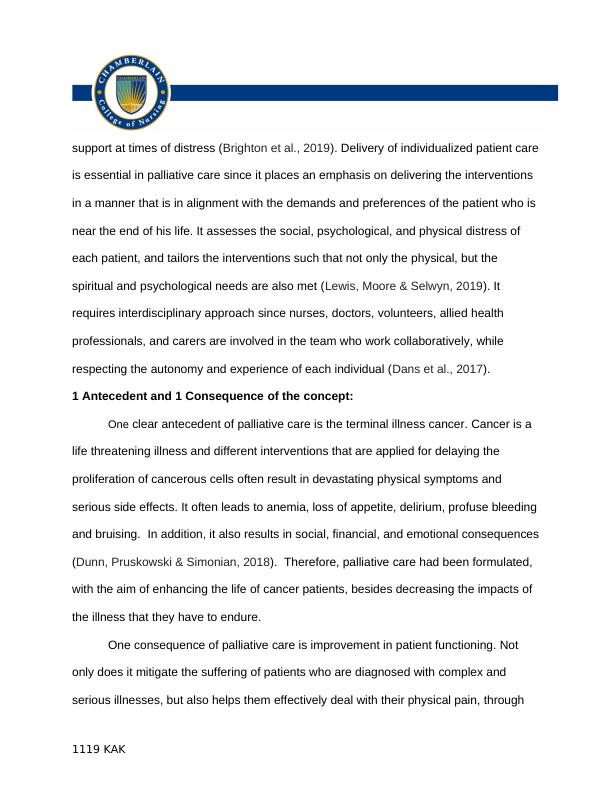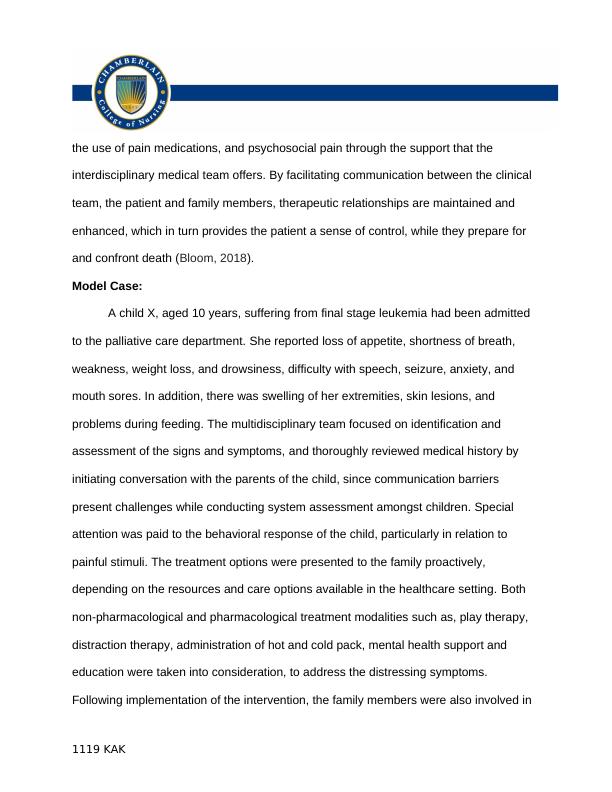Concept Analysis Template | Nursing
Added on 2022-08-18
7 Pages1632 Words11 Views
Concept Analysis Template
Name:
Definition/Explanation of the selected nursing concept:
Palliative care refers to the specialized medical approach that brings about an
improvement in the quality of life of patients and their family members, in relation to life-
threatening diseases, by preventing and providing an end to the suffering of the patients
(Watson, 2019). Palliative care focuses on early identification and a comprehensive
health assessment, following which it offers treatment for pain and existing
psychosocial, physical, and spiritual problems of patients. It considers death as a
normal procedure, and helps in the development of a support system that provides
assistance to patients to live as much as possible, until their death (Australia, 2018).
Three defining attributes:
The three major attributes of palliative care and namely (i) support for family
members, (ii) complete and individualized patient care, and (iii) interdisciplinary
teamwork. Family members who have a terminally ill patient are most often in transition.
Palliative care is based on the premise that family forms the core of care, and they are
considered as entities that can either resist or provide helpful efforts for the care
delivery. Palliative care aims to reduce the burden that the family faces, while seeing
their beloved one in a critically ill state, and also focuses on offering them emotional
1119 KAK
Name:
Definition/Explanation of the selected nursing concept:
Palliative care refers to the specialized medical approach that brings about an
improvement in the quality of life of patients and their family members, in relation to life-
threatening diseases, by preventing and providing an end to the suffering of the patients
(Watson, 2019). Palliative care focuses on early identification and a comprehensive
health assessment, following which it offers treatment for pain and existing
psychosocial, physical, and spiritual problems of patients. It considers death as a
normal procedure, and helps in the development of a support system that provides
assistance to patients to live as much as possible, until their death (Australia, 2018).
Three defining attributes:
The three major attributes of palliative care and namely (i) support for family
members, (ii) complete and individualized patient care, and (iii) interdisciplinary
teamwork. Family members who have a terminally ill patient are most often in transition.
Palliative care is based on the premise that family forms the core of care, and they are
considered as entities that can either resist or provide helpful efforts for the care
delivery. Palliative care aims to reduce the burden that the family faces, while seeing
their beloved one in a critically ill state, and also focuses on offering them emotional
1119 KAK

support at times of distress (Brighton et al., 2019). Delivery of individualized patient care
is essential in palliative care since it places an emphasis on delivering the interventions
in a manner that is in alignment with the demands and preferences of the patient who is
near the end of his life. It assesses the social, psychological, and physical distress of
each patient, and tailors the interventions such that not only the physical, but the
spiritual and psychological needs are also met (Lewis, Moore & Selwyn, 2019). It
requires interdisciplinary approach since nurses, doctors, volunteers, allied health
professionals, and carers are involved in the team who work collaboratively, while
respecting the autonomy and experience of each individual (Dans et al., 2017).
1 Antecedent and 1 Consequence of the concept:
One clear antecedent of palliative care is the terminal illness cancer. Cancer is a
life threatening illness and different interventions that are applied for delaying the
proliferation of cancerous cells often result in devastating physical symptoms and
serious side effects. It often leads to anemia, loss of appetite, delirium, profuse bleeding
and bruising. In addition, it also results in social, financial, and emotional consequences
(Dunn, Pruskowski & Simonian, 2018). Therefore, palliative care had been formulated,
with the aim of enhancing the life of cancer patients, besides decreasing the impacts of
the illness that they have to endure.
One consequence of palliative care is improvement in patient functioning. Not
only does it mitigate the suffering of patients who are diagnosed with complex and
serious illnesses, but also helps them effectively deal with their physical pain, through
1119 KAK
is essential in palliative care since it places an emphasis on delivering the interventions
in a manner that is in alignment with the demands and preferences of the patient who is
near the end of his life. It assesses the social, psychological, and physical distress of
each patient, and tailors the interventions such that not only the physical, but the
spiritual and psychological needs are also met (Lewis, Moore & Selwyn, 2019). It
requires interdisciplinary approach since nurses, doctors, volunteers, allied health
professionals, and carers are involved in the team who work collaboratively, while
respecting the autonomy and experience of each individual (Dans et al., 2017).
1 Antecedent and 1 Consequence of the concept:
One clear antecedent of palliative care is the terminal illness cancer. Cancer is a
life threatening illness and different interventions that are applied for delaying the
proliferation of cancerous cells often result in devastating physical symptoms and
serious side effects. It often leads to anemia, loss of appetite, delirium, profuse bleeding
and bruising. In addition, it also results in social, financial, and emotional consequences
(Dunn, Pruskowski & Simonian, 2018). Therefore, palliative care had been formulated,
with the aim of enhancing the life of cancer patients, besides decreasing the impacts of
the illness that they have to endure.
One consequence of palliative care is improvement in patient functioning. Not
only does it mitigate the suffering of patients who are diagnosed with complex and
serious illnesses, but also helps them effectively deal with their physical pain, through
1119 KAK

the use of pain medications, and psychosocial pain through the support that the
interdisciplinary medical team offers. By facilitating communication between the clinical
team, the patient and family members, therapeutic relationships are maintained and
enhanced, which in turn provides the patient a sense of control, while they prepare for
and confront death (Bloom, 2018).
Model Case:
A child X, aged 10 years, suffering from final stage leukemia had been admitted
to the palliative care department. She reported loss of appetite, shortness of breath,
weakness, weight loss, and drowsiness, difficulty with speech, seizure, anxiety, and
mouth sores. In addition, there was swelling of her extremities, skin lesions, and
problems during feeding. The multidisciplinary team focused on identification and
assessment of the signs and symptoms, and thoroughly reviewed medical history by
initiating conversation with the parents of the child, since communication barriers
present challenges while conducting system assessment amongst children. Special
attention was paid to the behavioral response of the child, particularly in relation to
painful stimuli. The treatment options were presented to the family proactively,
depending on the resources and care options available in the healthcare setting. Both
non-pharmacological and pharmacological treatment modalities such as, play therapy,
distraction therapy, administration of hot and cold pack, mental health support and
education were taken into consideration, to address the distressing symptoms.
Following implementation of the intervention, the family members were also involved in
1119 KAK
interdisciplinary medical team offers. By facilitating communication between the clinical
team, the patient and family members, therapeutic relationships are maintained and
enhanced, which in turn provides the patient a sense of control, while they prepare for
and confront death (Bloom, 2018).
Model Case:
A child X, aged 10 years, suffering from final stage leukemia had been admitted
to the palliative care department. She reported loss of appetite, shortness of breath,
weakness, weight loss, and drowsiness, difficulty with speech, seizure, anxiety, and
mouth sores. In addition, there was swelling of her extremities, skin lesions, and
problems during feeding. The multidisciplinary team focused on identification and
assessment of the signs and symptoms, and thoroughly reviewed medical history by
initiating conversation with the parents of the child, since communication barriers
present challenges while conducting system assessment amongst children. Special
attention was paid to the behavioral response of the child, particularly in relation to
painful stimuli. The treatment options were presented to the family proactively,
depending on the resources and care options available in the healthcare setting. Both
non-pharmacological and pharmacological treatment modalities such as, play therapy,
distraction therapy, administration of hot and cold pack, mental health support and
education were taken into consideration, to address the distressing symptoms.
Following implementation of the intervention, the family members were also involved in
1119 KAK

End of preview
Want to access all the pages? Upload your documents or become a member.
Related Documents
Palliative Care: Philosophy, Home-Based, Hospice, Aged Care, Chinese Culture, Nursing Ethics, and Bereavementlg...
|9
|2347
|268
Palliative Care of Children: Importance, Benefits and Approacheslg...
|6
|1239
|452
An Introduction to Palliative Carelg...
|12
|4063
|430
THE END OF LIFE CARElg...
|7
|1734
|38
Social Implications of Medical Issues - Deskliblg...
|13
|3759
|406
Reflection on Palliative Carelg...
|7
|2006
|402
